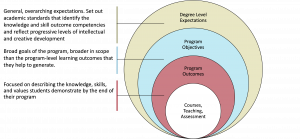5 Working with Program Learning Outcomes During CPR
Your self-study document should provide readers with an appreciation for how the program’s academic structure and requirements enable students to meet learning objectives and intended outcomes of the program. Components of Section 5 (particularly 5.1) focus on this narrative, providing space for clarity on the curricular structure, with strong emphasis on learning outcomes and academic requirements (e.g. the courses students take, the assessments, and learning that occurs therein). There is an overall expectation that the program’s structure and academic requirements align with and meet the University’s undergraduate or graduate Degree Level Expectations.
This chapter will enable you to work with program learning outcomes – to write, revise, or review them, depending on your identified needs. This chapter will introduce you to how learning outcomes then become the central core to the self-study and it’s goal of organizing the academic structure for reviewers. Beyond this chapter, next chapters then elaborate on these elements of the self-study:
Chapter 6: Aligning Program Outcomes to Degree Level Expectations
Chapter 7: Describing your Curriculum by Detailing Teaching, Assessment, and Modes of Delivery
Chapter 8: Progression of Learning: Capturing Teaching, Learning, and Assessments across the Academic Program
What are Program Learning Outcomes?
Learning outcomes are “clear and concise statements that describe what successful students should have achieved, as well as the knowledge, skills, and abilities that they should have acquired, by the end of the program. They articulate the expectations for student success—what students should know and/or know how to do by the end of the program” (Ontario Universities Council on Quality Assurance, 2021).
How do outcomes and objectives differ?

Program objectives are statements that describe the broad goals of the program. “Clear and thorough articulation of program objectives can provide transparency in what the program seeks to accomplish, describe to potential students why the discipline is important, and explain how the program is unique and meaningful in the context of the discipline as a whole” (Ontario Universities Council on Quality Assurance, 2021). For example, a program may have an objective to provide students with opportunities to engage with industry professionals through work-integrated learning
Program outcomes are more specific and are focused on describing the knowledge, skills, and values students demonstrate by the end of their program. “Program-level student learning outcomes emphasize the application and integration of knowledge rather than simply coverage of content. They articulate the expectations for student success—what students should know and/or know how to do by the end of the program” (Ontario Universities Council on Quality Assurance, 2021).
Objectives and outcomes are related. The objectives of your program should be reflected in your outcomes. That is, your goals for the program and for students’ learning during their studies, informs the types of knowledge, skills, and values that you intend to teach students.
Effective Program Learning Outcome Statements
Effective outcomes flow from a common stem focused on the learner’s end-state (e.g. by the end of the program, graduates will be able to…). Effective statements use action verbs to describe the nature and depth of learning. They describe the lasting knowledge, skills, or values in ways that are grounded and contextualized in the discipline or inter-/trans-disciplinarity of the program. Finally, they accurately target the appropriate level of study (e.g. undergraduate versus graduate depth, complexity, or level of independence).
Download this resource that further outlines and provides examples of these 5 effective qualities: Essential Qualities of Program Learning Outcome Statements (.pdf).
Write, Revise, or Review
Quick Connect to Write, Revise, Review Resources:
Ideal Graduate Activity (.pdf)
Reviewing Outcomes for Effective Qualities Guide (.pdf)
Action Verbs for Learning Outcomes (.pdf)
Continue to the next step of: Aligning Program Outcomes to Degree Level Expectations
Why Start with Learning Outcomes?
A large majority of Section 5 is oriented around the program learning outcomes. Solidify your outcomes first and the other elements of Section 5 become easier to orient. The principle at work here is that of Backward Design (Wiggens & McTighe, 2005) where curriculum is oriented upon the desired results of learning, framing assessment tasks and teaching approaches around how they support students to reach intended goals.
References
Ontario Universities Council on Quality Assurance. (2021). Program Objectives and Program-level Learning Outcomes. https://oucqa.ca/guide/program-objectives-and-program-level-learning-outcomes/
Wiggins, G., & McTighe, J. (2005). Understanding by Design, Association for Supervision & Curriculum Development, ProQuest Ebook Central, http://ebookcentral.proquest.com/lib/queen-ebooks/detail.action?docID=3002118

